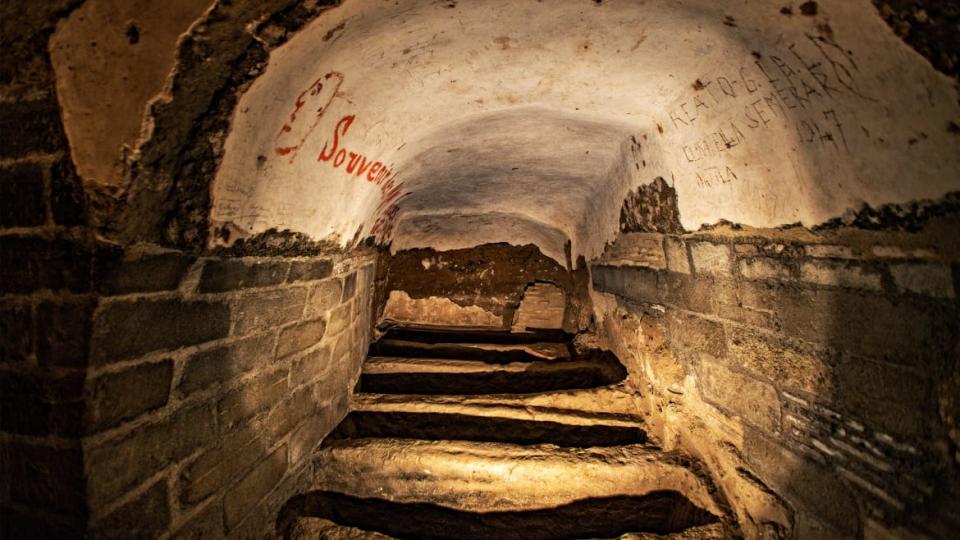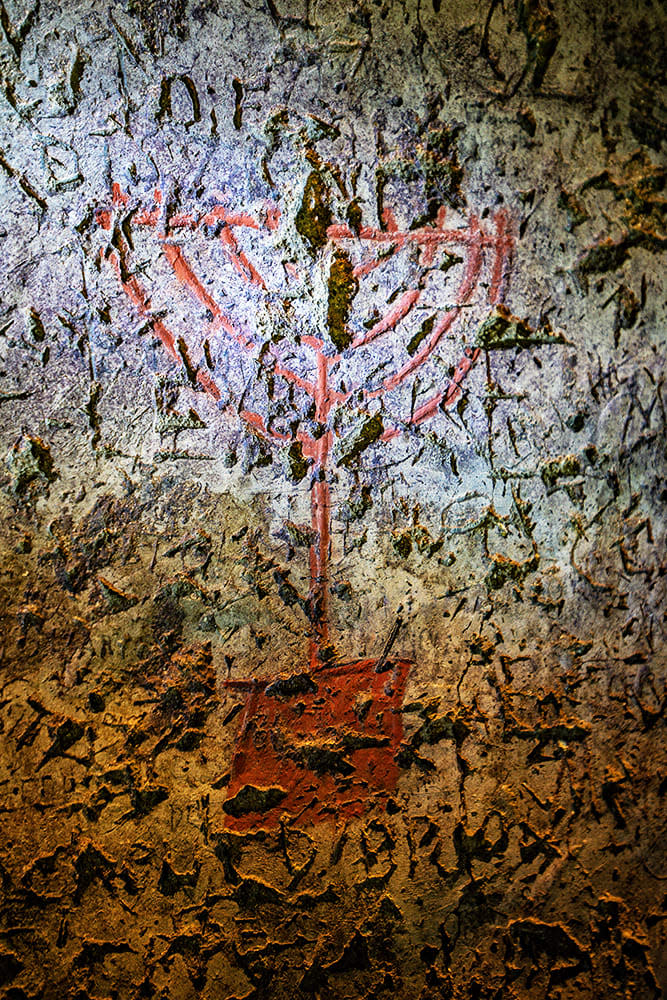Why Are There Christian Crosses in Jewish Graves From Ancient Rome?

The most pervasive and well-known symbol for Christianity is, of course, the cross. If you walk into a place of worship and there’s a cross you can feel fairly certain that you’re in Christian space. Which is why it might be surprising to learn that a network of ancient Jewish catacombs about a mile outside of Venosa, Italy, has crosses etched into the walls.
The burial grounds in question are the Santa Rufina catacombs, part of a network of subterranean galleries set into a hillside on the outskirts of Venosa, a quiet farming town that was once an important urban center and was the birthplace of the Roman poet Horace. The precise date of construction for the catacombs is unknown, but it seems likely that they were built and used between the fourth and sixth centuries. In other words, they were in use during a period when Christianity had grown solid roots and Roman emperors actively supported the flourishing of the Jesus religion.
Though they are less well known than their Roman counterparts, the Jewish catacombs in Venosa are unique both because of their superior preservation and because they continued to be used as late as the seventh century, long after the Jewish catacombs in Rome had fallen into disuse. The fact that the epitaphs are painted directly onto or close by to the tombs makes them a valuable repository of information about the previous occupants of the tombs. Giancarlo Lacerenza, professor of biblical and medieval Hebrew at L’Orientale University and leader of the Venusia Judaica research project, told me that the catacombs can provide us with valuable information about late antique and early medieval Italian Jews.
The Santa Rufina catacombs themselves are a relatively simple affair: two parallel corridors roughly eight to nine feet high are joined by connecting passages. Burial niches were cut into the soft rock and then sealed with plaster or brick. The graves of the less affluent were painted or scratched onto the plaster exterior while the wealthy might have had marble plaques or even a separate painted burial chamber. Unlike Christian catacombs, which often had chapels attached for services and memorial meals, Jewish catacombs might only have had a room where remains could be washed and prepared for burial.
The cemetery in Venosa was first unearthed in the 1850s. The use of the menorah and Hebrew language in the artwork that accompanies the tombs makes them easily recognizable to us, but it wasn’t immediately apparent to 19th-century locals what they were looking at. One eyewitness recognized certain symbols like the palm tree but declared the inscriptions to be “indecipherable.” Some hypothesized that it was a Saracen site. Jessica Dello Russo, a staff member on the Venusia Judaica project and co-editor of a recently published volume on the site, suggested that even though local residents couldn’t read the inscriptions “they might well have inspired a feeling that the caverns had magical or oracular powers.”
Excavating catacombs can be a dangerous and, therefore, expensive business. In the 1970s archeologist Cesare Colafemmina and his team gained access to a previously closed gallery that was still decorated with painted plaster walls and contained arched tomb niches, known as arcosolia. The walls were adorned with menorah, lulav (a frond of a palm tree used in Sukkot), ethrog (a citrus used during sukkot), and a shofar, which are recognizably Jewish symbols. Though Jewish burials were simple and didn’t involve extravagant jewelry or grave goods, this did not deter medieval looters. Though 12th-century Popes prohibited plundering Jewish graves and cemeteries, the Santa Rufina catacombs were cleaned out in the Middles Ages and only bone fragments and artwork still remain.

Italy Basilicata Venosa Jewish and Paleochristian catacombs, Faustini Tomb Menorah
In 1981 Eric Meyers, the Bernice and Morton Lerner Emeritus Professor of Jewish Studies at Duke University, was leading an excavation funded by the World Jewish Congress and ran across the Santa Rufina tunnels. He told The Daily Beast that they weren’t surprised to find crosses at the site. The same hillside housed members of a variety of different religious groups—Jewish, Christian, and polytheistic. The proximity of the catacombs to Christian burial grounds and a church made it likely that this was some kind of shared space. The question is, what is the relationship between the crosses and Jewish tombs?
One possibility, Dello Russo said, was that perhaps this was a sign of the reuse of the catacombs at a later period after Jews had left Venosa. The abandoned burial grounds were integrated into a hospice site during the medieval period and even, at one point used to house animals. The fact that the catacombs were exposed by a series of earthquakes both closed some of them and exposed others. A 16th-century commentator, Jacopo Cenna, notes that in his time how people would visit the site armed with torches, and even linger in the tunnels during the hot summer months when the catacombs provided respite from the heat. Even a 17th-century Bishop of Venosa, said Dello Russo, poked around and noted some eighty inscriptions in Hebrew at the site. It’s in this context, she said, that most of the crosses were engraved on the walls of the tombs.
Even though the crosses were effectively overwriting the Jewish identity of the site this does not mean that they were malicious. Dr. Dorota Hartman, a member of the project at the University of Naples “L’Orientale,” told me that when the crosses were engraved the locals probably did not identify these catacombs as specifically Jewish. Dello Russo agreed, “I don’t necessarily see the crosses as "cancelling" the Jewish presence in the site with a hateful gesture.” Though Jews were caricatured in Southern Italian folklore as an enemy in the Church that doesn’t necessarily inform what is happening here.
One or two of the crosses, Lacerenza said, are older. While he noted that the coexistence of Jews and Christians in the same catacomb remains to be proven, he suggested that perhaps the older mixed religious imagery represents the social realities of a bustling late antique society in which Jews and Christians were not segregated, shared space, and maybe even families: “The catacombs represent personal and private situations, not just public ones, and these family conditions, then as now, may have been complicated.”
Discoveries like this one are important because they can help us trace the social relationships and lived experiences of Jews living in Italy in a period when animosity towards them was growing. The fourth-century inscriptions in the Jewish catacombs are written in Greek (60 percent), Latin (30 percent), and Hebrew (10 percent) a testimony to the use of multiple languages in the same community. They provide archaeological evidence for the reality of religious and cultural pluralism in the region and ties to other communities. Names, places of origins, honorific titles from positions in local administration, and one intriguing reference to messengers (apostoloi, the same word we translate as Apostles) from the Middle East can flesh out our picture of life for Jews in Venosa.
While considerably more research needs to be done, the fact that the hillside has not been built over means that the site can continue to be studied. In our own time, when antisemitism is on the rise in Europe, retrieving and preserving the history of Jews in late antique Italy seems especially important.
Get our top stories in your inbox every day. Sign up now!
Daily Beast Membership: Beast Inside goes deeper on the stories that matter to you. Learn more.

 Yahoo Finance
Yahoo Finance 